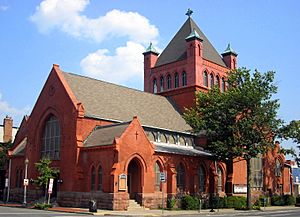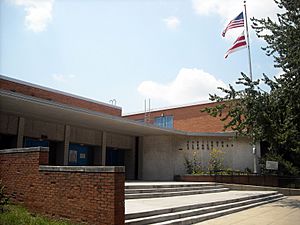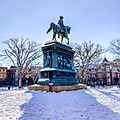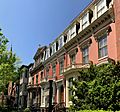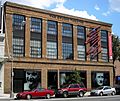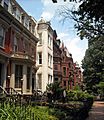Logan Circle (Washington, D.C.) facts for kids
Quick facts for kids
Logan Circle
|
|
|---|---|
|
Neighborhood of Washington, D.C.
|
|
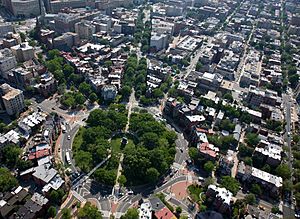
Aerial view of Logan Circle, facing southwest
|
|
| Country | United States |
| District | Washington, D.C. |
| Ward | Ward 2 |
| Area | |
| • Total | .17 sq mi (0.4 km2) |
| Population
(2010)
|
|
| • Total | 7,976 |
| • Density | 46,917.6/sq mi (18,115.0/km2) |
Logan Circle is a traffic circle park, neighborhood, and historic district in the Northwest quadrant of Washington, D.C. The primarily residential neighborhood includes two historic districts, properties listed on the National Register of Historic Places, and sites designated D.C. Historic Landmarks. Vermont Avenue NW, Rhode Island Avenue NW, 13th Street NW, and P Street NW meet at the circle. An equestrian statue of Major General John A. Logan stands at its center. It is the only major circle downtown that remains entirely residential.
Contents
History
19th century
During the Civil War, present-day Logan Circle was home to Camp Barker, former barracks converted into a refugee camp for newly freed slaves from nearby Virginia and Maryland. In the 1870s, streets, elm trees, and other amenities were installed by Washington Mayor Alexander Robey Shepherd, who encouraged the development of the area. Streetcar tracks were laid into what was then a very swampy area north of downtown Washington, to encourage development of the original Washington City Plan. As a result, the area saw development of successive blocks of Victorian row houses marketed to the upper middle class, which sought to give Washington the reputation, modeled after European capitals, of a city of broad boulevards and well-manicured parks. Many of the larger and more ornate homes came with carriage houses and attached servant's quarters, which were later converted to apartments and rooming houses as the upper middle class moved elsewhere.
20th century
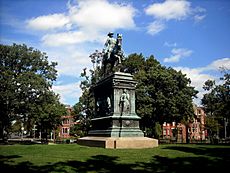
Originally known as Iowa Circle, the park was renamed by Congress in 1930 in honor of John A. Logan, Commander of the Army of the Tennessee during the Civil War, Commander of the Grand Army of the Republic, and U.S. representative and senator for the state of Illinois, who lived at 4 Logan Circle. At the center of the circle stands Major General John A. Logan, an equestrian statue of Logan sculpted by Franklin Simmons and a bronze statue base designed by architect Richard Morris Hunt. On April 9, 1901, the 25 feet (7.6 m) monument was dedicated by President William McKinley, Senator Chauncey Depew, and General Grenville M. Dodge.
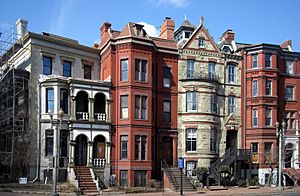
In the early 20th century, 14th Street NW rose to prominence as a main shopping district for both black and white Washingtonians on the edge of downtown Washington D.C., and became known as an area for auto showrooms. Further north, "14th and U" became synonymous with a large African-American community, later known as Shaw, which encompassed parts of Logan Circle and U Street to the north. Segregation marked the emergence of this large area of well-preserved Victorian row houses as a predominately African-American community; the unofficial dividing line was 16th Street NW, several blocks to the west, with Logan Circle and its older homes sandwiched in between.
During this period, the original Victorian homes in the area were subdivided into apartments, hostels, and rooming houses. with the end of legal segregation, middle-class residents of both races left the area. Many left after the destructive 1968 Washington, D.C. riots following the assassination of Martin Luther King, Jr. These devastated the 14th and U streets commercial corridors.
In 1956, the three inner lanes of 13th Street were paved across Logan Circle to speed the influx of suburban workers into DC. In 1980, to encourage more people to use Metro, the inner lanes across Logan Circle were closed. Later they were removed and the park restored.
21st century
During the 2000s, the area gentrified and housing costs sharply increased after derelict buildings were torn down or remodeled. The commercial corridors along 14th and P streets attracted significant revitalization. They now feature a variety of retailers, restaurants, art galleries, live theater, and nightlife venues such as Number Nine and Trade, gay bars catering to the neighborhood's booming LGBT population.
A watershed event in the development of the neighborhood was the opening of a Whole Foods Market two blocks from Logan Circle in December 2000. No full grocery store was in the area. It was developed on a site previously occupied by an abandoned service garage; it is now one of the chain's highest-grossing markets. Gentrification in Logan Circle has resulted in a dramatic change of neighborhood demographics; since the 1990s, thousands of White young LGBT & hipster adults have moved into the neighborhood, while thousands of Black families have moved out because of rising prices.
Geography
The Logan Circle neighborhood is bordered:
- on the north by S Street NW and the U Street Corridor (a.k.a. Cardozo/Shaw) neighborhood;
- on the east by 10th Street NW and the Shaw neighborhood:
- on the south by M Street NW and the Downtown area
- on the west by 16th Street NW and the Dupont Circle neighborhood
The traffic circle is the intersection of 13th Street, P Street, Rhode Island Avenue, and Vermont Avenue. The National Park Service maintains the land located within the traffic circle, a park measuring 360 feet (110 m) in diameter, furnished with wooden benches, decorative lampposts, an iron fence, and concrete sidewalks.
Landmarks
|
Logan Circle Historic District
|
|
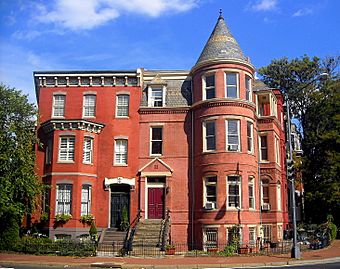
Row houses on the northeast corner of Logan Circle, including the former residence (right) of writer Ambrose Bierce
|
|
| Location | Junction of 13th Street, P Street, Rhode Island Avenue, and Vermont Avenue, NW |
|---|---|
| Area | 18 acres (7.3 ha) |
| Architectural style | Second Empire, Italianate, Richardsonian Romanesque, Queen Anne |
| NRHP reference No. | 72001426 |
| Added to NRHP | June 30, 1972 |
Logan Circle Historic District
The Logan Circle Historic District is an eight-block area surrounding the circle, containing 135 late-19th-century residences designed predominantly in the Late Victorian and Richardsonian Romanesque styles of architecture. The district was added to the National Register of Historic Places on June 30, 1972.
The former home of Mary McLeod Bethune, an African American educator, author, and civil rights leader who founded the National Council of Negro Women, is located at 1318 Vermont Avenue NW, one block south of the circle. The Second Empire-style building is a designated National Historic Site and houses the Mary McLeod Bethune Memorial Museum and the National Archives for Black Women's History.
Fourteenth Street Historic District
In addition to the Logan Circle Historic District, the neighborhood includes the much larger Fourteenth Street Historic District, added to the NRHP in 1994. The district's approximately 765 contributing properties are considered historically significant because they represent residential and commercial development resulting from one of the earliest streetcar lines in Washington, D.C., the Capital Traction Company's 14th Street line, built in the 1880s.
The oldest house of worship in the Fourteenth Street Historic District is Luther Place Memorial Church, built 1870–1873, an ELCA Lutheran church situated on the north side of Thomas Circle. Originally known as Memorial Evangelical Lutheran Church of Washington, D.C., the building was renamed in 1884 after a bronze statue of Martin Luther was installed on the church's property. Luther Place Memorial Church was added to the National Register of Historic Places on July 16, 1973.
The Gladstone and Hawarden, designed by architect George S. Cooper in 1900, are early examples of Washington's middle class apartment houses. Named for U.K. Prime Minister William Gladstone and his estate Hawarden Castle, they are the first documented twin apartment buildings in Washington, D.C. The Gladstone and Hawarden were added to the NRHP on September 7, 1994.
Local landmarks
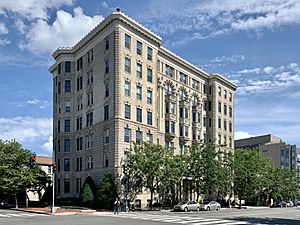
The District of Columbia Inventory of Historic Sites includes several properties in Logan Circle which are not listed on the National Register of Historic Places. Among them are the former residences of: Charles Manuel "Sweet Daddy" Grace, flamboyant founder of the United House of Prayer For All People; John A. Lankford, the first African American architect in Washington, D.C.; Belford Lawson, Jr., lead attorney in the landmark case New Negro Alliance v. Sanitary Grocery Co.; Alain LeRoy Locke, the first African American Rhodes Scholar and central figure in the Harlem Renaissance; Mary Jane Patterson, the first African American woman to earn a bachelor's degree; Ella Watson, subject of Gordon Parks's famous photograph American Gothic, Washington, D.C.; and James Lesesne Wells, noted graphic artist and longtime art instructor at Howard University.
The Victorian building on the north side of the park, 15 Logan Circle, was built for military officer and diplomat Seth Ledyard Phelps and served as the Korean legation from 1889 to 1905. Following an extensive restoration project, the building now serves as the Old Korean Legation Museum.
Education
Residents are served by the District of Columbia Public Schools (DCPS). Garrison Elementary School in Logan Circle has a capacity of over 350 students. As of 2013[update] the school had 228 students.
In 2013 Kaya Henderson, the chancellor of DCPS, proposed closing Garrison. Parents campaigned to save it. The school remained open and DCPS agreed to help modernize it. By 2015 renovations were delayed.
Residents are zoned to Garrison, and Cardozo Education Campus.
Images for kids
-
The General Logan equestrian statue commemorates Civil War general John A. Logan. Designed by sculptor Franklin Simmons, it was dedicated in 1901 by President William McKinley.
-
The Iowa, built in 1901, took its name from Iowa Circle, which was officially renamed by the U.S. Congress in honor of General Logan in 1930.
-
A row of Victorian townhomes on Vermont Avenue beside the Mary McLeod Bethune House.



